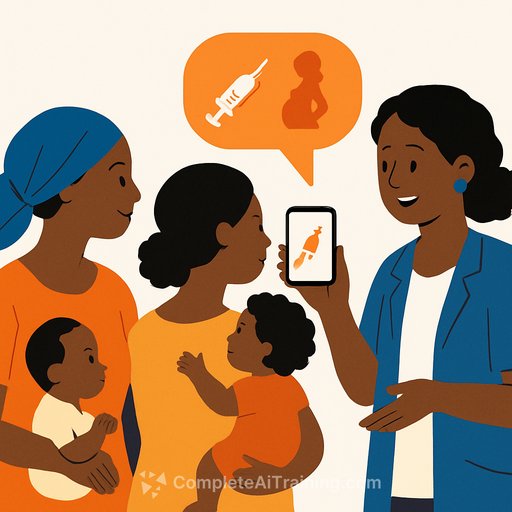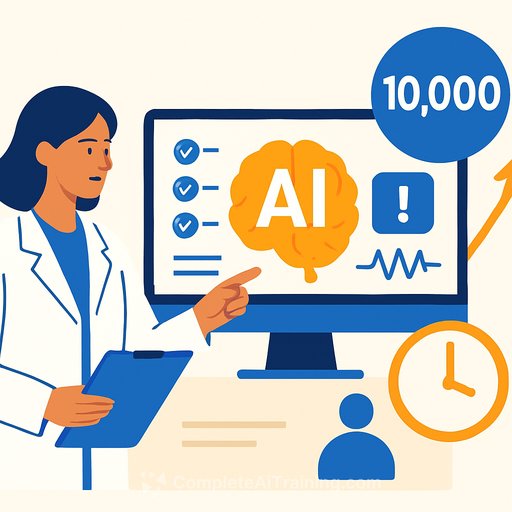Vaccines and motherhood: are AI-generated health messages working in Kenya and Nigeria?
AI can spin a catchy slogan. Traditional campaigns can sound official. Neither consistently wins trust where it matters: with real people making real health decisions.
In Kenya and Nigeria, we assessed 120 health messages on vaccine hesitancy and maternal care. Eighty came from ministries and NGOs; forty were AI-generated. The verdict: AI was creative but error-prone. Traditional campaigns were credible but rigid. The shared gap was cultural fit and community voice.
What AI did well-and where it failed
AI pulled in local slang, metaphors, and community-focused phrasing more often than human-made content. It tried to speak "with" people, not "at" them.
But many references were shallow or off-base. A slogan like "YOUNG, LIT, AND VAXXED!" may entertain, yet it can land awkwardly when tied to fertility fears. Some AI-generated images distorted faces or misrepresented people of color-an ongoing dataset problem that erodes trust.
Even health-focused tools struggled. The WHO's S.A.R.A.H sometimes gave incomplete answers and required resets. A default white female avatar raises representation questions for global audiences.
Where traditional campaigns fell short
Human-led campaigns leaned hard on clinical language and western medical frames. They often sidelined community knowledge and traditional practices, even where these shape health decisions.
This dynamic echoes a wider pattern seen during COVID-19: a hierarchy of expertise that left lower-income countries with less access and less voice. The result is predictable-people tune out messaging that talks down to them.
The shared miss: empowerment
Across both approaches, communities were treated as passive recipients of expert advice. Few messages invited dialogue, surfaced local beliefs, or enabled informed choice.
For vaccine hesitancy and maternal health, that gap is costly. Without trust and cultural relevance, uptake stalls and preventable harm follows.
Why this matters for your work
AI adoption in African health systems is accelerating across telemedicine, sexual and reproductive health, and operations. There are bright spots, from diagnostic support in Kenya to new access points in Nigeria. But without community-informed design, AI can repeat old mistakes at digital speed.
Your mandate isn't "AI vs. human." It's accuracy plus cultural responsiveness, proven in the field.
Practical guide: build health messages that work
- Co-design with the community. Involve local health workers, mothers, youth leaders, and traditional authorities from day one.
- Ground content in localized data. Train and fine-tune models on regionally relevant language, beliefs, and care pathways.
- Run tight feedback loops. Test drafts in small groups. Iterate weekly. Keep what resonates; cut what confuses.
- Segment by context. Don't reuse rural metaphors for urban audiences or vice versa.
- Pair AI with human review. Clinical validation by licensed professionals is non-negotiable. Add cultural reviewers before publishing.
- Avoid stereotypes in text and imagery. Use ethically sourced visuals that reflect the audience authentically. Audit generative images for bias.
- Translate for meaning, not word-for-word. Prioritize comprehension and emotional tone over literal accuracy.
- Make sources visible. Cite local clinics, health ministries, and recognized community experts.
- Add pathways to care. Every message should point to where, when, and how to get services.
- Measure and learn. Track reach, comprehension, trust signals, and behavior change (appointments, ANC visits, vaccinations).
Checklist for vaccine hesitancy and maternal health
- Fertility myths: Address directly with clear, evidence-based statements. Keep it simple; avoid jargon.
- Trusted messengers: Feature midwives, community health workers, and faith/traditional leaders known locally.
- Benefits first: Emphasize protection of mothers, babies, and family stability. Tie guidance to daily life.
- Timing and access: Include clinic hours, costs, transport options, and what to bring.
- Two-way engagement: Offer hotlines, WhatsApp groups, and community forums for questions and concerns.
- Continuity of care: Link antenatal, delivery, and postnatal support in one simple flow.
What to stop doing
- Chasing "cool" slang to force relevance. It backfires fast on sensitive topics like fertility.
- Using a single message for diverse regions, languages, and age groups.
- Leaning on stock images or AI visuals that misrepresent skin tones, clothing, or settings.
- Centering western expertise while muting community knowledge and lived experience.
- Publishing opaque AI content without expert review and disclosure.
Build local capacity
Invest in homegrown tools and teams. Platforms like AwaDoc show how locally built systems can reflect culture and maintain clinical accuracy.
Fund data stewardship, fair participant compensation, and transparent model documentation. Shared ownership builds trust-and better outcomes.
A 90-day rollout plan
- Days 0-30: Map audience segments and myths. Convene a community advisory group. Draft 10 message variants per segment.
- Days 31-60: Field-test in small cohorts. Run A/B tests on tone, imagery, and calls to action. Build a clinician-and-community review panel.
- Days 61-90: Launch in phases. Monitor comprehension, trust, and conversion to care. Retire underperformers. Scale what works.
Bottom line
AI is a tool, not a shortcut. The win comes from pairing medical accuracy with genuine cultural relevance-and inviting communities to lead the conversation.
Upskill your team
If your team is building AI literacy for safer, more effective health communication, explore these resources:
Your membership also unlocks:






